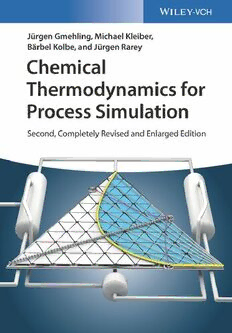
Chemical Thermodynamics for Process Simulation PDF
Preview Chemical Thermodynamics for Process Simulation
ChemicalThermodynamicsforProcessSimulation Chemical Thermodynamics for Process Simulation JürgenGmehling,MichaelKleiber,BärbelKolbe,and JürgenRarey Second,CompletelyRevisedandEnlargedEdition Authors AllbookspublishedbyWiley-VCH arecarefullyproduced.Nevertheless, Prof.Dr.JürgenGmehling authors,editors,andpublisherdonot CarlvonOssietzkyUniv.Oldenburg warranttheinformationcontainedin FakultätV-Mathematikund thesebooks,includingthisbook,to Naturwissenschaften befreeoferrors.Readersareadvised InstitutfürChemie-TechnischeChemie tokeepinmindthatstatements,data, 26111Oldenburg illustrations,proceduraldetailsorother Germany itemsmayinadvertentlybeinaccurate. Dr.-Ing.MichaelKleiber LibraryofCongressCardNo.: thyssenkruppIndustrialSolutionsAG appliedfor Friedrich-Uhde-Str.2 65812BadSoden BritishLibraryCataloguing-in-Publication Germany Data Acataloguerecordforthisbookis Dr.-Ing.BärbelKolbe availablefromtheBritishLibrary. thyssenkruppIndustrialSolutionsAG -nowretired- Bibliographicinformationpublishedby Germany theDeutscheNationalbibliothek TheDeutscheNationalbibliotheklists Dr.JürgenRarey thispublicationintheDeutsche CarlvonOssietzkyUniv.Oldenburg Nationalbibliografie;detailed FakultätV-Mathematikund bibliographicdataareavailableonthe Naturwissenschaften Internetat<http://dnb.d-nb.de>. InstitutfürChemie-TechnischeChemie 26111Oldenburg ©2019Wiley-VCHVerlagGmbH& Germany Co.KGaA,Boschstr.12,69469 Weinheim,Germany Cover Thecoverimagewaskindly Allrightsreserved(includingthoseof providedbyMarkGmehling translationintootherlanguages).No partofthisbookmaybereproducedin anyform–byphotoprinting, microfilm,oranyothermeans–nor transmittedortranslatedintoa machinelanguagewithoutwritten permissionfromthepublishers. Registerednames,trademarks,etc.used inthisbook,evenwhennotspecifically markedassuch,arenottobe consideredunprotectedbylaw. PrintISBN:978-3-527-34325-6 ePDFISBN:978-3-527-80945-5 ePubISBN:978-3-527-80944-8 oBookISBN:978-3-527-80947-9 CoverDesign SCHULZGrafik-Design, Fußgönheim,Germany Typesetting SPiGlobal,Chennai,India PrintingandBinding Printedonacid-freepaper 10 9 8 7 6 5 4 3 2 1 v Contents Preface xiii PrefacetotheSecondEdition xvii ListofSymbols xix AbouttheAuthors xxix 1 Introduction 1 2 PvTBehaviorofPureComponents 5 2.1 GeneralDescription 5 2.2 CaloricProperties 10 2.3 IdealGases 14 2.4 RealFluids 16 2.4.1 AuxiliaryFunctions 16 2.4.2 ResidualFunctions 17 2.4.3 FugacityandFugacityCoefficient 19 2.4.4 PhaseEquilibria 22 2.5 EquationsofState 25 2.5.1 VirialEquation 26 2.5.2 High-PrecisionEquationsofState 30 2.5.3 CubicEquationsofState 37 2.5.4 GeneralizedEquationsofStateandCorresponding-States Principle 42 2.5.5 AdvancedCubicEquationsofState 49 Problems 57 References 60 3 CorrelationandEstimationofPureComponentProperties 63 3.1 Introduction 63 3.2 CharacteristicPhysicalPropertyConstants 63 3.2.1 CriticalData 64 3.2.2 AcentricFactor 69 3.2.3 NormalBoilingPoint 69 3.2.4 MeltingPointandEnthalpyofFusion 72 3.2.5 StandardEnthalpyandStandardGibbsEnergyofFormation 74 vi Contents 3.3 Temperature-DependentProperties 77 3.3.1 VaporPressure 78 3.3.2 LiquidDensity 90 3.3.3 EnthalpyofVaporization 94 3.3.4 IdealGasHeatCapacity 98 3.3.5 LiquidHeatCapacity 105 3.3.6 SpeedofSound 109 3.4 CorrelationandEstimationofTransportProperties 110 3.4.1 LiquidViscosity 110 3.4.2 VaporViscosity 115 3.4.3 LiquidThermalConductivity 120 3.4.4 VaporThermalConductivity 125 3.4.5 SurfaceTension 128 3.4.6 DiffusionCoefficients 131 Problems 135 References 138 4 PropertiesofMixtures 143 4.1 Introduction 143 4.2 PropertyChangesofMixing 144 4.3 PartialMolarProperties 145 4.4 Gibbs–DuhemEquation 148 4.5 IdealMixtureofIdealGases 150 4.6 IdealMixtureofRealFluids 152 4.7 ExcessProperties 153 4.8 FugacityinMixtures 154 4.8.1 FugacityofanIdealMixture 155 4.8.2 PhaseEquilibrium 155 4.9 ActivityandActivityCoefficient 156 4.10 ApplicationofEquationsofStatetoMixtures 157 4.10.1 VirialEquation 158 4.10.2 CubicEquationsofState 159 Problems 169 References 170 5 PhaseEquilibriainFluidSystems 173 5.1 Introduction 173 5.2 ThermodynamicFundamentals 185 5.3 ApplicationofActivityCoefficients 192 5.4 CalculationofVapor–LiquidEquilibriaUsinggEModels 195 5.5 FittingofgEModelParameters 212 5.5.1 CheckofVLEDataforThermodynamicConsistency 218 5.5.2 RecommendedgEModelParameters 227 5.6 CalculationofVapor–LiquidEquilibriaUsingEquationsofState 229 5.6.1 FittingofBinaryParametersofCubicEquationsofState 235 5.7 ConditionsfortheOccurrenceofAzeotropicBehavior 243 5.8 SolubilityofGasesinLiquids 252 Contents vii 5.8.1 CalculationofGasSolubilitiesUsingHenryConstants 254 5.8.2 CalculationofGasSolubilitiesUsingEquationsofState 262 5.8.3 PredictionofGasSolubilities 263 5.9 Liquid–LiquidEquilibria 266 5.9.1 TemperatureDependenceofTernaryLLE 277 5.9.2 PressureDependenceofLLE 279 5.10 PredictiveModels 280 5.10.1 RegularSolutionTheory 281 5.10.2 GroupContributionMethods 282 5.10.3 UNIFACMethod 284 5.10.3.1 ModifiedUNIFAC(Dortmund) 291 5.10.3.2 WeaknessesoftheGroupContributionMethodsUNIFACand ModifiedUNIFAC 295 5.10.4 PredictiveSoave–Redlich–Kwong(PSRK)EquationofState 302 5.10.5 VTPRGroupContributionEquationofState 306 Problems 315 References 319 6 CaloricProperties 323 6.1 CaloricEquationsofState 323 6.1.1 InternalEnergyandEnthalpy 323 6.1.2 Entropy 326 6.1.3 HelmholtzEnergyandGibbsEnergy 327 6.2 EnthalpyDescriptioninProcessSimulationPrograms 329 6.2.1 RouteA:VaporasStartingPhase 330 6.2.2 RouteB:LiquidasStartingPhase 334 6.2.3 RouteC:EquationofState 335 6.3 CaloricPropertiesinChemicalReactions 343 Problems 349 References 350 7 ElectrolyteSolutions 351 7.1 Introduction 351 7.2 ThermodynamicsofElectrolyteSolutions 355 7.3 ActivityCoefficientModelsforElectrolyteSolutions 360 7.3.1 Debye–HückelLimitingLaw 360 7.3.2 BromleyExtension 361 7.3.3 PitzerModel 361 7.3.4 NRTLElectrolyteModelbyChen 364 7.3.5 LIQUACModel 372 7.3.6 MSAModel 380 7.4 DissociationEquilibria 381 7.5 InfluenceofSaltsontheVapor–LiquidEquilibriumBehavior 383 7.6 ComplexElectrolyteSystems 385 Problems 386 References 386 viii Contents 8 Solid–LiquidEquilibria 389 8.1 Introduction 389 8.2 ThermodynamicRelationsfortheCalculationofSolid–Liquid Equilibria 392 8.2.1 Solid–LiquidEquilibriaofSimpleEutecticSystems 394 8.2.1.1 FreezingPointDepression 401 8.2.2 Solid–LiquidEquilibriaofSystemswithSolidSolutions 402 8.2.2.1 IdealSystems 402 8.2.2.2 Solid–LiquidEquilibriaforNonidealSystems 403 8.2.3 Solid–LiquidEquilibriawithIntermolecularCompoundFormationin theSolidState 406 8.2.4 PressureDependenceofSolid–LiquidEquilibria 409 8.3 SaltSolubility 409 8.4 SolubilityofSolidsinSupercriticalFluids 414 Problems 416 References 419 9 MembraneProcesses 421 9.1 Osmosis 421 9.2 Pervaporation 424 Problems 425 References 426 10 PolymerThermodynamics 427 10.1 Introduction 427 10.2 gEModels 433 10.3 EquationsofState 444 10.4 InfluenceofPolydispersity 460 10.5 InfluenceofPolymerStructure 464 Problems 465 References 467 11 ApplicationsofThermodynamicsinSeparation Technology 469 11.1 Introduction 469 11.2 VerificationofModelParametersPriortoProcess Simulation 474 11.2.1 VerificationofPureComponentParameters 474 11.2.2 VerificationofgEModelParameters 475 11.3 InvestigationofAzeotropicPointsinMulticomponentSystems 483 11.4 ResidueCurves,DistillationBoundaries,andDistillationRegions 484 11.5 SelectionofEntrainersforAzeotropicandExtractiveDistillation 491 11.6 SelectionofSolventsforOtherSeparationProcesses 499 11.7 SelectionofSolvent-BasedSeparationProcesses 499 Problems 503 References 504
